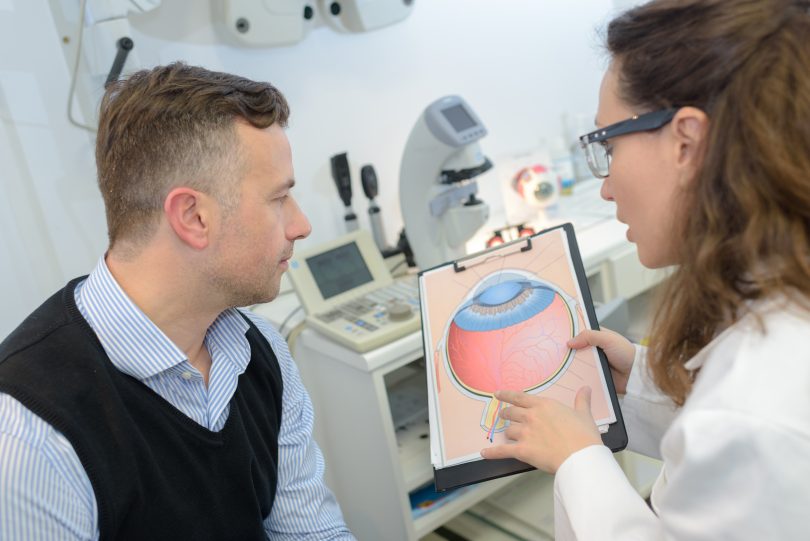Glaucoma was one of the very first conditions to be treated with medical cannabis, but over time it’s been determined that certain cannabinoids can make the condition worse.
Back in 1971, Hepler and Frank reported a 25–30% drop in intraocular eye pressure in a small number of subjects who had recently smoke cannabis. To this day, glaucoma is still a commonly cited reason for prescribing medical cannabis.
When it comes to glaucoma, the cannabinoid most commonly associated with healthcare – CBD – is actually detrimental to this condition. Historically, THC has been successful treatment option, but new studies indicate that another cannabinoid might be even more effective – CBG or cannabigerol.
Click here or use the sign up form below to subscribe to the Medical Cannabis Weekly Newsletter
What is Glaucoma?
Glaucoma is a condition categorized by increased pressure in the eye, called intraocular eye pressure, caused by fluid buildup in the front part of the eye. Over time, the pressure builds up and damages the optic nerve, which is what sends images from your eyes to your brain. This can eventually lead to blindness.
Glaucoma is the second-leading cause of blindness in the United States. There are certain criteria that make certain people predisposed to glaucoma. It’s more likely to effect African Americans and Hispanics, and it’s there is an elevated risk for people who have a family history of this condition. Other risk factors include: thinner corneas, chronic eye inflammation and certain medications.
Glaucoma effects more than 3 million Americans, 2.7 million of whom are over the age of 40. Although it primarily effects adults, there is an infant (congenital) form that exists. There are two main types of glaucoma: Primary open-angle glaucoma, which happens gradually over a long period of time; and Angle-closure glaucoma, which is acute onset and considered a true ocular emergency.
What is CBG?
Since cannabigerol is usually only present in cannabis in very small amounts – normally less than 1 percent – it’s considered a minor cannabinoid. CBG is important for another reason though, and that is its ability to synthesize other major cannabinoids. Because of this, CBGA (cannabigerolic acid) has been appropriately nicknamed “The Mother of Cannabinoids”.
CBGA is a direct line to three main cannabinoids: tetrahydrocannabinolic acid (THCA), cannabidiolic acid (CBDA), and cannabichromenic acid (CBCA). Once exposed to heat or light during a process referred to as decarboxylation, THCA, CBDA, and CBCA will shed their carboxyl acid group and become THC, CBD, and CBC, respectively
If we’re following the pattern above, CBGA should break down to CBG, but this doesn’t happen very often. Usually, certain enzymes break down CBGA and it is immediately converted to THCA, CBDA, or CBCA. This is why more THC means less CBG, because of the unique way these compounds interact and are synthesized.
However, in certain strains, CBGA naturally converts to CBG. These strains are low in THC and easily able to pass compliance standards. To get more flowers with these high levels of CBG, breeders are practicing plant cross-breeding and other forms of genetic manipulation.
The Research: CBG for Glaucoma
CBG may also help with treating glaucoma, because of the way it reduces intraocular pressure. Our eyes contain many endocannabinoid receptors which can be activated by cannabinoids like CBG. When activated, the result can be a shift in intraocular pressure. While cannabinoids in general have been suggested as helpful for this, some studies show that CBG may be particularly helpful with decreasing pressure and expediting the draining of fluids.
A study https://www.ncbi.nlm.nih.gov/pubmed/1965836 conducted by the Department of Ophthalmology at West Virginia University Health Sciences Center North in Morgantown, determined that “After chronic administration of CBG unilaterally to the cornea via Alzet osmotic minipumps and connecting extraocular cannulas, a considerable fall in ocular tension amounting to 4 to 7 mm Hg occurred. Both CBG and THC produced a two-to three-fold increase in aqueous outflow facility. These results suggest that cannabigerol and related cannabinoids may have therapeutic potential for the treatment of glaucoma.”
What is CBG and What Are Its Benefits?
Final Thoughts
CBG is cannabinoid that hasn’t gotten much attention but seems to have very much therapeutic value, and this is especially true when it comes to treating glaucoma, which can be a completely debilitating condition. Endocannabinoid receptors are prevalent in eye structures, and interestingly, CBG is thought to be particularly effective in treating glaucoma because it reduces intraocular pressure. It is a powerful vasodilator and has neuroprotective effects to boot.
For more stories about cannabinoids and ocular health, subscribe to the Medical Cannabis Weekly Newsletter.
To BUY CBG FLOWERS – Subscribe to the CBD Flowers Business Newsletter (brands/companies/businesses) – OR – the CBD Flowers Weekly (consumers).




CBG and especially CBGA are a trully magic cannabinoids. Even the thought that CBGA converts to all other acid forms of cannabinoids is amazing.
From what I have read, when you smoke cannabis and you get the red eyes…this is also said that it helps prevent glaucoma.